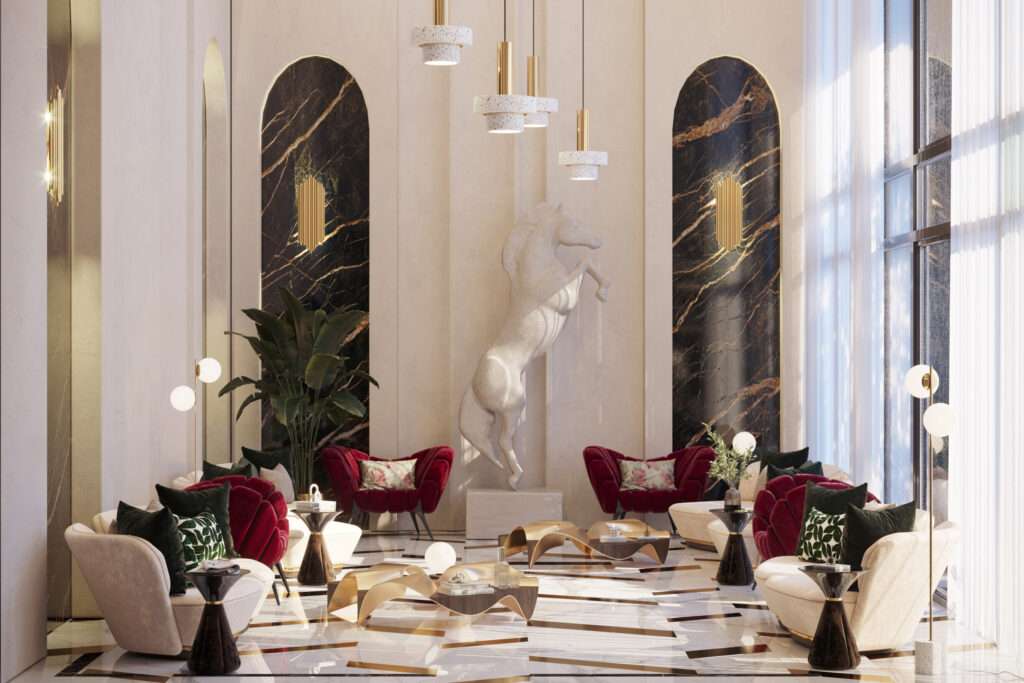When designing interiors, achieving balance and harmony is key to creating spaces that feel cohesive and inviting. One of the most effective ways to do this is through symmetry. Symmetry has been used for centuries in art, architecture, and design, as it evokes feelings of order and tranquility. At Scale & Structure, we believe that symmetry is a powerful design tool that can help you create stunning and visually pleasing interiors. In this guide, we’ll explore how to use symmetry in your home to enhance its beauty and create a balanced atmosphere.

1. Understanding Symmetry in Interior Design
Symmetry in interior design refers to the arrangement of elements in a balanced way. There are two primary types of symmetry commonly used in interiors:
- Axial Symmetry (Bilateral Symmetry): This type of symmetry involves creating balance on either side of a central axis. It’s often used in spaces like living rooms, bedrooms, and foyers where items like furniture or décor are mirrored.
- Radial Symmetry: This type of symmetry revolves around a central point, with elements arranged in a circular pattern around it. It is often used in more open spaces like dining areas or circular rooms.
By using symmetry, you can create a sense of visual harmony that feels both comfortable and sophisticated. Symmetry doesn’t have to mean exact duplication of items, but it’s about achieving balance through the careful arrangement of design elements.
2. Symmetry in Furniture Arrangement
One of the most common ways to use symmetry in interior design is through the arrangement of furniture. Symmetry helps create a sense of order, making the space feel more intentional and put-together. Here’s how you can use symmetry in your furniture layout:
Living Room:
- Sofa and Chairs: Place a central piece like a sofa as the focal point and arrange chairs or sofas symmetrically on either side. For example, two identical armchairs on either side of a sofa creates a balanced look.
- Coffee Table and Accessories: Position a coffee table in the center, and balance the space with matching lamps or décor items on either side. This symmetry creates a feeling of stability and calm.
- Area Rugs: Use a symmetrical rug placement, where the rug is centered in front of the sofa and chairs to tie the space together.
Bedroom:
- Bedding and Nightstands: A bed in the center of the room with matching nightstands on either side instantly creates symmetry. This layout evokes a sense of calm and order, which is perfect for a restful environment.
- Mirrors and Lighting: Place symmetrical light fixtures or mirrors above the nightstands to balance the room visually and enhance the symmetry of the layout.
Dining Room:
- Dining Table and Chairs: A rectangular or round dining table with symmetrical seating arrangements on both sides creates a balanced and inviting space. If you have a larger table, you can even use matching chairs or benches on either side to maintain symmetry.
- Pendant Lighting: Consider symmetrical pendant lighting above the dining table. A pair of identical or matching lights can frame the table and draw attention to the center of the room.
3. Using Symmetry in Wall Décor
Symmetry isn’t just for furniture; it can also be used in wall décor to create visually pleasing interiors. Symmetrical arrangements of art, mirrors, and shelves can bring structure to the room while adding interest and style.
Artwork:
- Gallery Walls: When arranging artwork, symmetry can help tie the space together. Use matching frames and evenly space the pieces on either side of a focal point like a sofa or bed.
- Single Large Artwork: A large piece of art can act as the central point of symmetry, with furniture and accessories arranged symmetrically around it.
- Mirrors: A large, symmetrical mirror above a console table or in the entryway can reflect light and visually enlarge the space. Pairing it with matching sconces or other symmetrical elements can enhance the effect.
Shelves:
- Symmetrical Shelving: In a bookshelf or open shelving unit, balance the placement of items to create symmetry. This could be as simple as having identical vases or books arranged in mirrored pairs.
- Floating Shelves: Install floating shelves symmetrically on either side of a room to balance the space. These shelves can be used for books, décor, or plants.
Wall Panels or Wallpaper:
- If you want to add texture to the walls, consider symmetrical wall panels or a patterned wallpaper that can draw the eye upward and create visual balance.
4. Symmetry in Lighting Design
Lighting is another element where symmetry plays a significant role in creating harmony in a space. Thoughtfully placed lights can enhance the symmetrical layout of a room, adding elegance and highlighting key design elements.
Ceiling Fixtures:
- Chandeliers or pendant lights can be used symmetrically above a dining table, kitchen island, or in the center of a room. They should be centered above the focal point to draw attention and maintain balance.
Table and Floor Lamps:
- Use identical table lamps or floor lamps on either side of a console table, sofa, or bed. This adds symmetry while providing functional lighting.
5. Symmetry in Color Schemes
Symmetry can also extend to your choice of color scheme. By pairing balanced colors, you can visually unify the elements in a room and create an aesthetically pleasing environment.
- Neutral Palettes with Pops of Color: Symmetrical color schemes, such as using neutral tones on either side of a focal point and adding pops of color on opposite sides, can create harmony.
- Matching Fabrics: For upholstered furniture, choose fabrics in similar tones or patterns on both sides of the room. This ensures the space feels balanced without being overly rigid.
A symmetrical color palette might involve pairing complementary colors on either side of the room, such as two throw pillows of the same color on each side of the sofa or alternating cushions that mirror each other.
6. Symmetry in Architectural Elements
Finally, symmetry can be achieved through architectural details such as windows, doors, and built-in features. Symmetry in these elements often provides the foundational structure for other design features in the room.
- Windows and Doors: In a living room or bedroom, having paired windows or double doors on opposite sides of a room can create a symmetrical framework for the layout.
- Fireplaces: A symmetrical fireplace design creates a natural focal point. Pairing it with symmetrical built-in shelves or furniture arrangements can reinforce the balance.
Why It Works:
Architectural symmetry sets the stage for your furniture and décor to follow suit. It helps ensure that even when the other elements in the room are asymmetrical, the structural balance of the space remains intact.
7. When to Use Asymmetry Alongside Symmetry
While symmetry is a powerful design tool, it’s important to note that asymmetry can also play a crucial role in creating visual interest and avoiding overly rigid spaces. Consider balancing symmetry with asymmetry by introducing an unexpected element—such as an off-center piece of art or a uniquely shaped chair. This will still maintain the overall harmony but can prevent the room from feeling too formulaic.



